PinotFile: 8.19 August 8, 2010
|
IPNC: Continuing Education in Living Well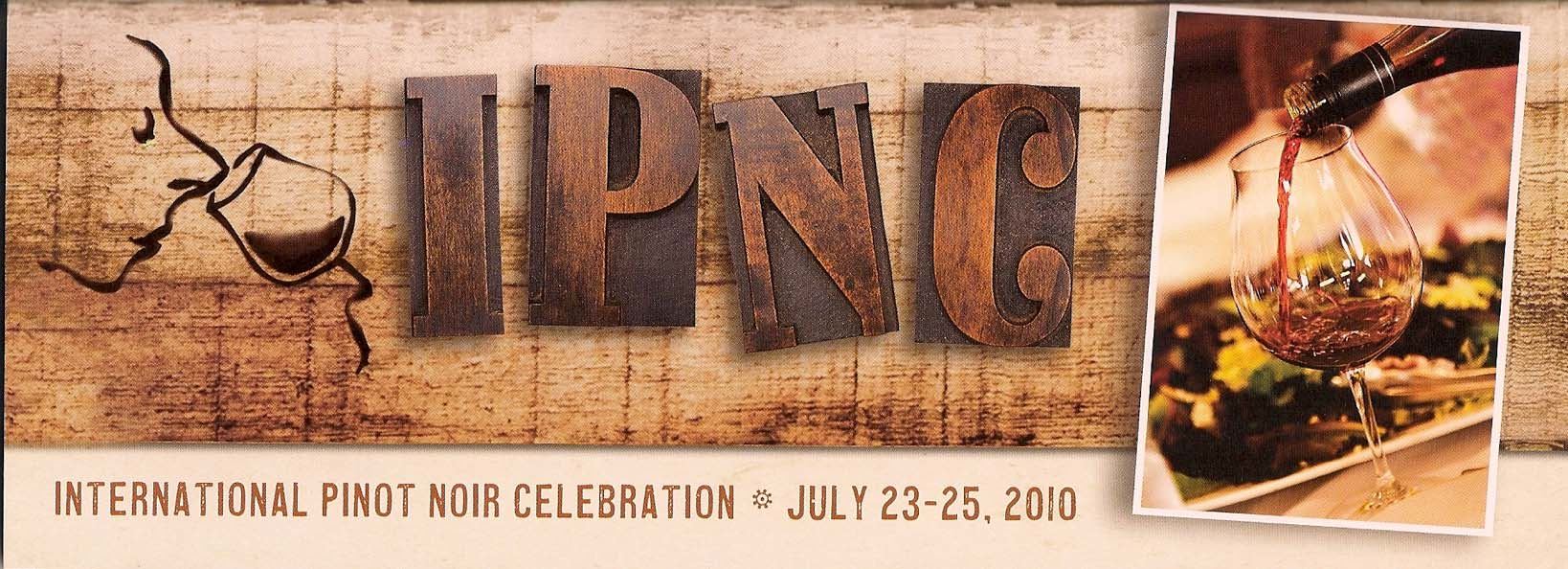
Each summer during late July, over 600 pinotphiles from all over the world gravitate to the small, bucolic campus of Linfield College in Mc Minnville, Oregon to indulge in their beloved grape. The college is magically transformed into “Beaune in the USA.” No homework or written tests, and no dreadful lectures in the early morning; just an abundance of great Pinot Noir paired with the delicious bounty of Oregon prepared by the Pacific Northwest’s most talented chefs. This year’s International Pinot Noir Celebration (IPNC) was the event’s 24th. Back in 1987, a group of winegrowers and winemakers gathered to figure out a way to promote Oregon wine. The IPNC was born that year, and since then, IPNC has hosted more than 275 foreign wineries and brought nearly 13,000 pinotphiles from all over the United States and the world to McMinnville to rejoice in a common devotion to Pinot Noir. The popularity of IPNC has generated spin-offs around the world including Pinot Noir events in California, Wellington and Central Otago, New Zealand, and the Mornington Peninsula region of Victoria, Australia. This year there were 70 featured Pinot Noir producers from Oregon, California, Burgundy, Alsace, Argentina, Australia, Austria, Canada, Germany, Italy, and New Zealand. The emphasis is always on quality and stylistic diversity with many new faces appearing each year. There is no judging of wines at this event. It is a pure celebration of Pinot Noir, offering the Pinot Noir enthusiast the opportunity to discover new producers and rub shoulders with established winemakers of repute that they may have only read or heard about. Winemakers, winegrowers, winery owners and winery representatives as a group outnumber consumers at IPNC. The IPNC is truly unique among wine festivals in that the food rivals the wine. This year’s event tee shirt boldly declared, “Food + Wine = IPNC.” The meals here are original, astonishingly fresh, and made with local artisan created farm-to-table ingredients. The mantra is, “What grows together, goes together.” Oregon is blessed with a bounty of gastronomic riches including wild mushrooms, a diverse array of berries and fruits, salmon, shellfish, cheeses, bakeries, home-style charcuterie, bacon and hams, organic dairy farms, hazelnuts, coffee roasters, and a crop of outstanding chefs. This year there were 52 featured guest chefs along with 31 members of the chef support team and 32 maîtres d’hôtel. A full listing of the participants is on the IPNC website (www.ipnc.org). I have copied a couple of the menus from the event showing the cuisine. The menu on the left was served at Soléna & Grand Cru Estate Winery and the menu on the right on the campus of Linfield college (attendees have lunch on campus one day and at a winery another day).
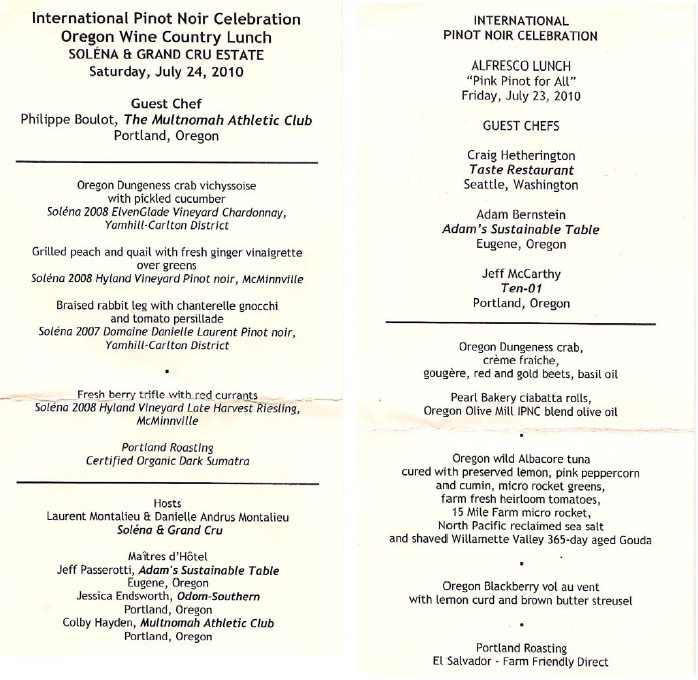 The Saturday night Northwest Salmon Bake is held in an oak grove on the Linfield College campus. Now in its 23rd year, it is a much-loved tradition at IPNC, and has been called, “The most entertaining meal at any wine event in the world.” Wild salmon is cooked native northwest style on wood stakes over a 60 by 15 foot fire pit fueled by fir and alder. Many volunteers from the Depoe Bay Chamber of Commerce brave the heat and provide the succulent salmon each year for guests. The menu is below.
Noted photographers Andrea Johnson and Robert Holmes joined Jay Selman of Grape Radio and myself in
videotaping this year’s IPNC. For some of the photos of IPNC visit: www.andreajohnson.photoshelter.com/invite/g/U0000eeEePPJOBkw/G0000TIjoc1zH3es/
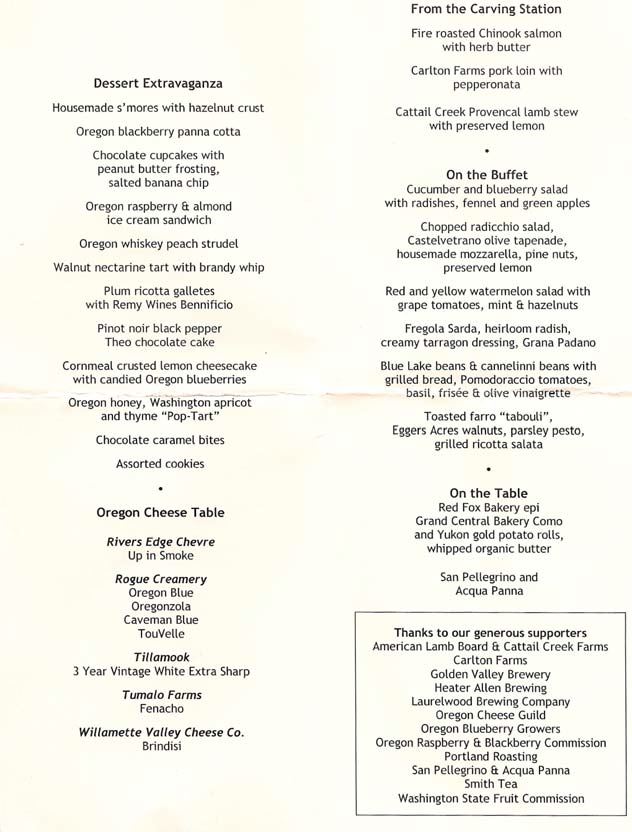
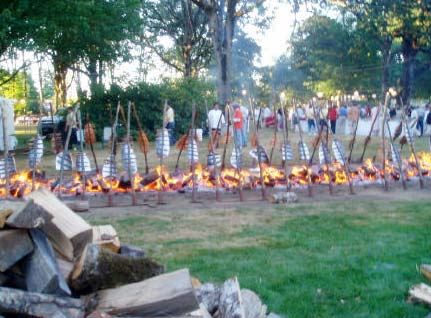 The wine flows at the luncheons and especially the two dinners where many guests bring wines to share. Scott Wright of Scott Paul Wines told me his most memorable experience at IPNC was one year at the Salmon Bake when someone offered him a taste of 1961 DRC Romanee-Conti and he had to pour out some 1959 DRC La Tache to taste it. My most memorable wines this year? 2001 Privé Willamette Valley Pinot Noir, 2007 Domaine Jacques-Frédéric Mugnier Les Amoureuses 1er Cru, 2007 J. Hofstätter Barthenau Italy Pinot Noir, 2007 Domaine de l’Arlot Clos des Forêts Saint Georges, 1er Cru, 2009 Bodega Chacra Argentina Pinot Noir, 2007 Navarro Vineyards Deep End Blend Anderson Valley Pinot Noir, 2008 Anam Cara Cellars Estate Reserve Willamette Valley Pinot Noir, 2008 Anne Amie Willamette Valley Pinot Noir, 2008 Benton Lane Estate Willamette Valley Pinot Noir, 2008 Lange Estate Winery Three Hills Cuvée Willamette Valley Pinot Noir, 2008 Scott Paul Audrey Willamette Valley Pinot Noir, and 2008 St. Innocent Shea Vineyard Willamette Valley Pinot Noir. Since I was involved in producing a video of the IPNC experience, I did not have time to do extensive tastings or take detailed tasting notes to pass on. I didn’t lament because this event is not really a venue for serious wine tasting. The featured wineries pouring at the event include the following:
*Australia - Yering Station *Austria - Johanneshof Reinisch *Canada - Henry of Pelham Family Estate Vineyard (Ontario), Tantalus Vineyards (British Columbia), and Tawse Winery (Ontario) *France - Domaine Albert Mann (Alsace), Maison Ambroise, Domaine de l’Arlot, Domaine Ballorin & F, Domaine David Clark, Domaine Jean-Jacques Confuron, Domaine Humbert Fréres, Domaine Jean-René Nudant, and Domaine Marc Roy. *Germany - Schlossgut Diel *Italy - J. Hofstätter *New Zealand - Churton Wines (Marlborough), Kawarau Estate (Central Otago), and Pegasus Bay (Central Otago) *California - Anthill Farms Winery, Calera Wine Company, Drew Wines, Dutton-Goldfield Winery, Expression Wines, Fiddlehead Cellars, Flowers Vineyard & Winery, La Follette Wines, Lynmar Estate, Navarro Vineyards, The Ojai Vineyard, Saintsbury, Schug Carneros Estate, Stephen Ross Wine Cellars, Talley Vineyards *Oregon - Adelsheim Vineyard, Anam Cara Cellars, Andrew Rich Wines, Anne Amie Vineyards, Benton Lane Winery, Bergström Wines, Boedecker Cellars, Brandborg Vineyard & Winery, Brooks Wines, Chehalem, Cristom Vineyards, De Ponte Cellars, Domaine Serene, Elk Cove Vineyards, Erath Winery, The Eyrie Vineyards, Illahe Vineyards & Winery, Patton Valley Vineyard, Ponzi Vineyard, R. Stuart & Co., Raptor Ridge Winery, Redhawk Vineyard & Winery, Roco Winery, Scott Paul Wines, Sokol Blosser Winery, St. Innocent Winery, Van Duzer Vineyards, Westrey Wine Company, Willamette Valley Vineyards, Winderlea Vineyard & Winery, Witness Tree Vineyard.
The featured seminar was titled, “Wine is Food: The Art of Pairing Pinot.” Session #1 was hosted by Master of
Ceremonies, Ray Isle, Wine Editor of Food & Wine, who led a discussion and tasting of four Pinot Noirs made
by Dan Goldfield of California’s Dutton Goldfield (2007 Freestone Hill), Lynnette Hudson of New Zealand’s
Pegasus Bay (2006 Prima Donna), Olivier Leriche of Burgundy’s Domaine de l’Arlot (Clos de Forts 1er), and
Mark Vlossak of Oregon’s St. Innocent Winery (2007 Momtazi Vineyard). Each winemaker commented on how
they were influenced by food. Session #2 was hosted by Master Sommelier and Perfect Pairings author Evan
Goldstein who was joined by celebrated northwest chefs, Renée Erickson of Seattle’s The Boat Street Cafe,
Kevin Gibson of Portland’s Evoe, Jason Stoller Smith of Oregon’s Timberline Lodge, and Cathy Whims of
Portland’s Nostrana. Each chef created a pairing for one of the four Pinots served in Session #1 using a
different cut of lamb. The chefs discussed the process they go through in identifying the style and
characteristics of a wine and how they create a complimentary recipe that allows both elements to shine.
Listen to Session #2. "IPNC 2010 The Art of Pairing Pinot" After this year’s event, I came away with ten salient comments about Oregon Pinot Noir. 1. First off, you must learn how to pronounce “Oregon” and “Willamette” correctly so you don’t sound like a rube when you visit. Oregonians insist you say, “OR-eh-gun,” not “Or-EE-gun” or Or-ee-Gone.” When referring to Oregon’s major Pinot Noir producing region, the Willamette Valley, do not say, “Will-a-MET.” Locals insist that it is “Will-AM-it,” dammit! 2. Oregon’s main marketing message is about it’s high quality, sustainable agriculture and stewardship of the land. A majority of Oregon’s 400+ wineries are LIVE certified, a first-of-its-kind sustainable winery and vineyard certification program. LIVE is an acronym meaning Low Input Viticulture and Enology. It refers to the practice of limiting the amount of raw materials such as pesticides, fertilizer, water, chemicals, fuel, etc., used in the vineyard and winery production. Salmon-Safe certification is included in the voluntary LIVE certification membership. This is the highest certification in the world for sustainable viticulture. An article appeared in the New York Times in April 2010 highlighting the emphasis on sustainable viticulture in Oregon (www.nytimes.com/2010/04/30/travel/30ecowine.html). Currently, there are 24 wineries and 160 vineyards certified LIVE in Oregon. LIVE certified wines are reviewed to insure they qualify within certain limits. These wines must contain at least 97% LIVE-certified fruit, total sulfur dioxide must be below 120 mg/L, chaptalization must be below 20 g/L, and all other state and federal requirements must be met. Beginning in 2008, labels of wines not produced in a LIVE certified winery must use the text, “Made With LIVE Certified Grapes,” to distinguish them from those produced in a certified facility. Wineries producing LIVE-certified wines include Amity Vineyards, Benton-Lane, Bethel Heights Vineyard, Illahe Vineyards, Patton Valley Vineyards, Ponzi Vineyards, Van Duzer Vineyards, Willakenzie Vineyards, Willamette Valley Vineyards, Winter’s Hill Vineyard and Witness Tree Vineyard.
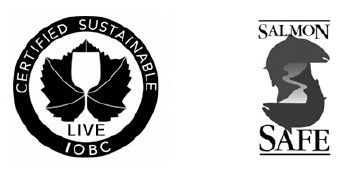 Oregon wineries are at the forefront of biodynamic farming. Below are photos of Momtazi Vineyard, at 200 acres, the largest Demeter Certified Biodynamic® vineyard in North America. A presentation of the preparations used in biodynamic farming was made to IPNC guests by proprietor Moe Momtazi (green shirt) The final photo is of Maysara winemaker, Tahmiene Momtazi, who is crafting remarkably good Pinot Noir from Momtazi Vineyard.
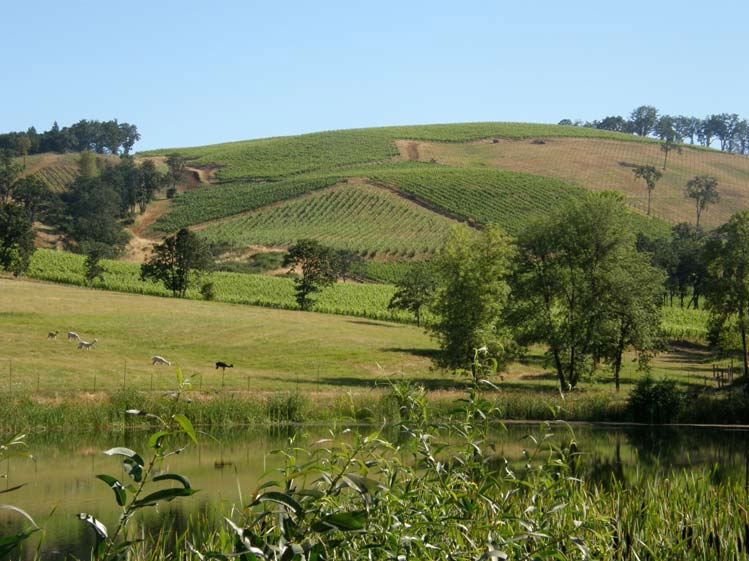
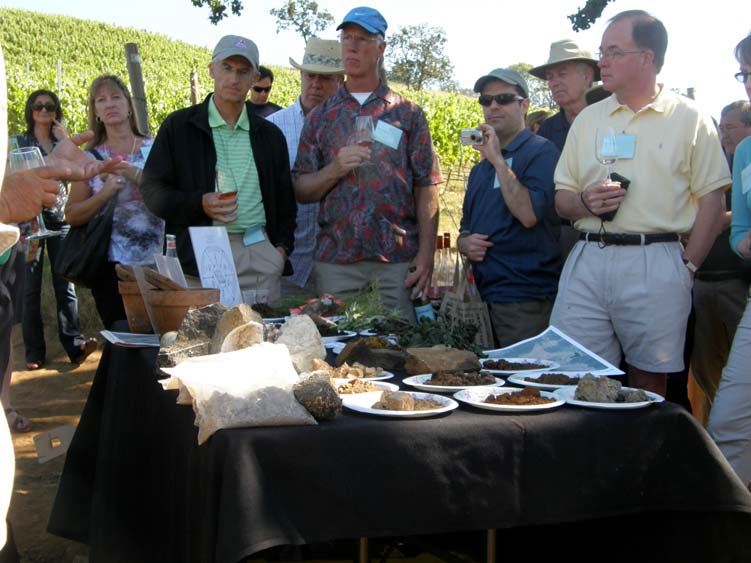
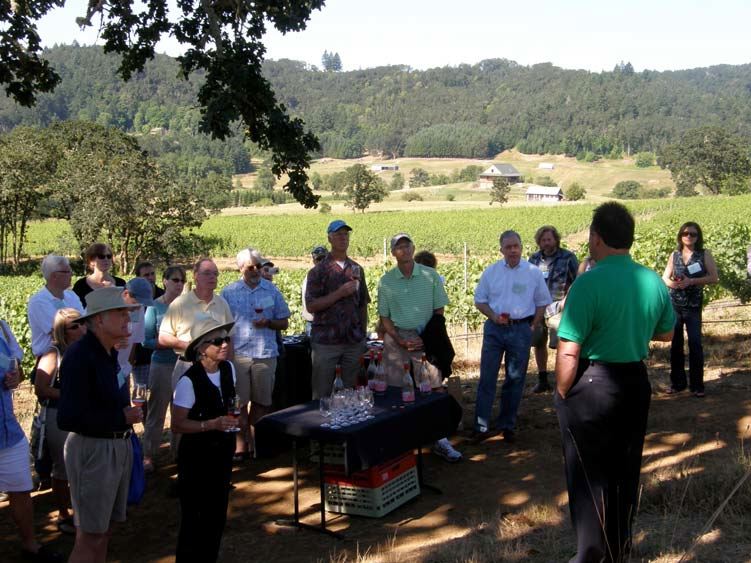
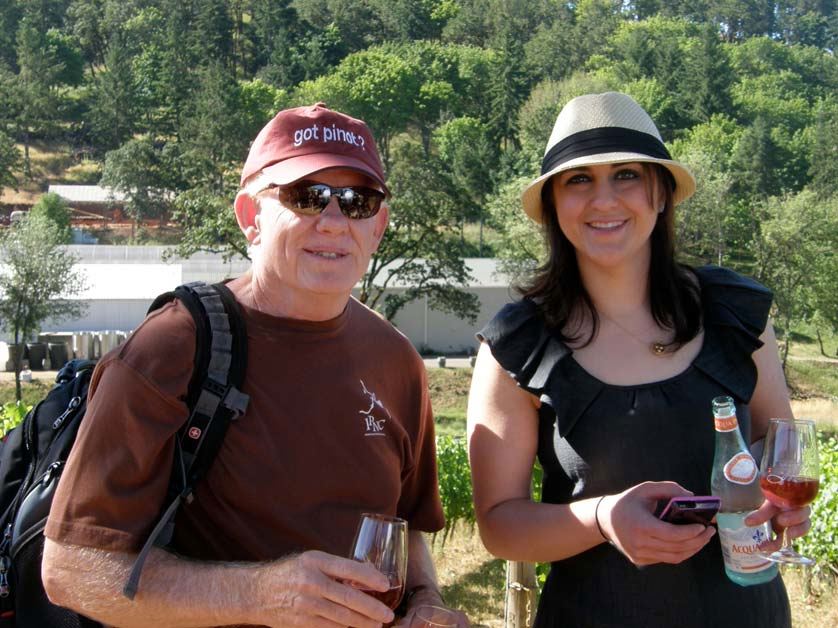
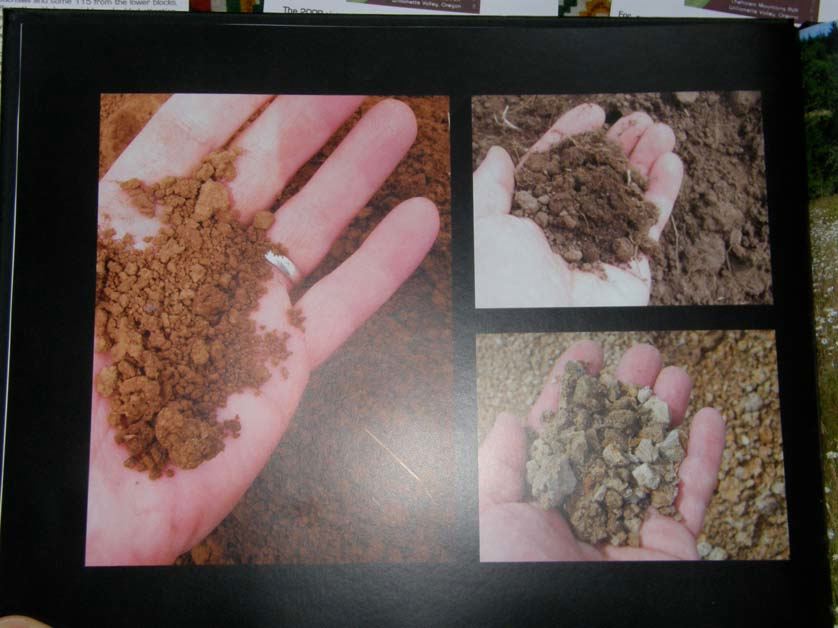 4. There are approximately 15,000 acres of vineyards planted in the Willamette Valley, primarily Pinot Pinot Noir with lesser amounts of Pinot Gris, Chardonnay, Riesling and Pinot Blanc. Total Pinot Noir acreage in Oregon in 2009 was 11,210 acres (8,713 acres harvested). 5. The 2007 vintage for Pinot Noir in Oregon was derided by many members of the wine press when the wines were first presented for tasting. The 2007 vintage was plagued by rain at harvest, with between 5 to 6 inches of rain occurring between late September and late October. Matt Kramer, a respected wine columnist for The Oregonian, noted, “Oregon’s 2007 Pinot Noirs are emerging as rather light, sometimes excessively thin wines that may prove to be overpriced for their quality.” As a generalization this statement may have some validity but my experience (and I tend to sample primarily higher-end Pinot Noirs from top producers) has been that the 2007 Pinot Noirs are exemplary of classic Pinot Noir, with lower alcohols, higher acidities, and elegant, charming flavors. As I tasted a number of Willamette Valley Pinot Noirs on my recent trip, and spoke to a number of winemakers, it was the consensus among them and my general impression that the 2007 Pinot Noirs have picked up more weight and flavor interest with another year in the bottle, and these are often stellar wines that provide superb near-term drinking. 6. The 2008 vintage for Oregon Pinot Noir may be the greatest this decade. The wines possess perfect balance with moderate alcohols and acidity harmonizing with ripe tannins and bright fruit. That said, the wines are tight and restrained at present and will need another few years in bottle to really shine. These are wines made for the long haul, and many will easily last 15 years. I suggest finding a few favorites and buying at least a case of each so that you can sample them over their evolution. 7. The 2009 Willamette Valley Pinot Noirs tasted from barrel are exciting and promiscuous wines that unlike their 2008 brethren, will be flirty and showy upon release. 8. Do not discount the age ability of warm vintages in Oregon. I tasted three relatively “hot” vintages of Shea Wine Cellars Estate Pinot Noir - 2003, 2006 and 2009. The 2003 wine was holding beautifully. Many reports have claimed the 2003 Pinot Noirs are not aging well and this will definitely be the case in unbalanced, high alcohol, low acidity wines. The 2006 Pinot Noir was also drinking well, although I found the fruit on the very ripe side. The 2009 Pinot Noir will be a crowd pleaser with its showy dark fruit and silky mouth feel. 9. Don’t forget about Oregon Chardonnay. In the early years of the modern era of winegrowing in Oregon, plantings of Chardonnay contained Wente and Draper clones from California that were unsuitable for Oregon’s cool climate. The wines were often thin, acidic and lacked character. The efforts of David Adelsheim and others beginning in 1974 led to the widespread introduction of Dijon clones of Chardonnay. The Dijon clones matured before bad weather set in at the end of Oregon’s harvest, proving to be a better match to Oregon’s climate. The use of Dijon clones (D76 is the most widely planted) combined with proper rootstocks and vine spacing produced Chardonnays with excellent structure, balanced acidity and mature flavors. In 2009, the Oregon Chardonnay Alliance (ORCA) was formed to promote the “rebirth” of Oregon Chardonnay (www.oregonchardonnay.org). Two of my favorites are Domaine Drouhin Oregon Arthur Chardonnay and Shea Wine Cellars Chardonnay (Shea is known for Pinot Noir but is seriously committed to Chardonnay as well, having recently planted 2 more acres of Chardonnay and producing around 600 cases annually). 10. Speaking of Chardonnay, the funniest comment I heard at the IPNC was made by Ray Isle, the Master of Ceremonies, who spiked his welcoming address to attendees with humor. Ray was describing the devotion to Pinot Noir that has led to many celebratory events in the grape’s honor. In contrast, he said, “If they celebrated Chardonnay, they would have to call this event the ICCC (as in “ick”).”
Next year is the 25th Annual International Pinot Noir Celebration: The Reunion, July 29-31, 2011. The event will reunite winemakers, chefs, media and guests from the first event in 1987 and the past 24 Celebrations. You may think you are a Pinot Noir hot shot. You have a case of La Tache in your cellar, you are on a first name basis with Joe Rochioli, you receive an allocation of 3 cases of Kosta Browne each year, and your first born is already learning about biodynamic viticulture at your local Waldorf school. The truth is, you aren’t squat if you haven’t attended the IPNC. You just aren’t in the fraternity. You must be in McMinnville next year for the 25th. Early bird pricing is $895 for the entire event until the end of the year. Just do it! Visit ipnc.org. E-mail me for questions, inside tips on lodging, and area activities and wineries to visit before and after the event.
Lange Estate: Exceptional Wines in 2008David and Diana Lett began the age of modern winegrowing in the Willamette Valley in 1966, with others such as Dick and Kena Erath, Dick and Nancy Ponzi, Susan and Bill Sokol Blosser, and David and Ginny Adelsheim following shortly thereafter. They were all seeking the same goal: to successfully grow Pinot Noir in a region previously considered too cold to ripen the grape that not only liked cool but was cool itself. These pioneers proved the naysayers wrong and before long, there were several thousand acres of Pinot Noir thriving in the Willamette Valley. Don and Wendy Lange were to plant their claim in the Dundee Hills of the Williamette Valley in 1987, only a half mile from Domaine Drouhin Oregon, the 100-acre estate founded the same year by Robert Drouhin of Maison Joseph Drouhin of Beaune, Burgundy. The Lange’s small property was very modest in comparison, and when the Lange’s released their first commercial wine in 1987, they located their tasting room in the basement of their farmhouse, a homey venue that was to host many wine lovers until 1999. Today, the Langes have a modern winery and tasting room with panoramic views of the Cascade Mountain Range and the Willamette Valley landscape below. The Lange’s chose to specialize in Pinot Noir, Chardonnay and Pinot Gris. The latter variety is of particular significance as Don was the fourth to plant Pinot Gris in the Willamette Valley and the first to release a barrel fermented reserve. The wine is still produced today and is considered a benchmark for the varietal in Oregon. Don’s talents as a winemaker were to bring quick success to Lange Estate Winery & Vineyards (noted wine writer Hugh Johnson called his work as winemaker “brilliant”). He strikes you as an unassuming sort with a twinkle in his eye (he would make a magnetic Santa Claus), but when you delve into his background, you find that he as an extremely talented singer-songwriter whose tunes have been sung and recorded by Pete Seeger, Christy Moore, and Kate Wolf, among many others. As his website (www.donlange.com) proclaims, “He is, simply, the finest songwriter to make great new world Pinot Noir and the best winemaker to ever write great songs.” Don attributes a large part of his success to his spouse, Wendy, who as CEO tends the day-to-day business of running the winery, the tasting room and the ever-present cadre of winery dogs. The Lange’s Shetland sheepdog, Lucy, is the September 2011 cover dog in the Wine Dogs USA calendar (www.winedogs.com). She has managed to imbibe the winery with a homey, welcoming atmosphere, and visitors are treated as if they were long time friends.
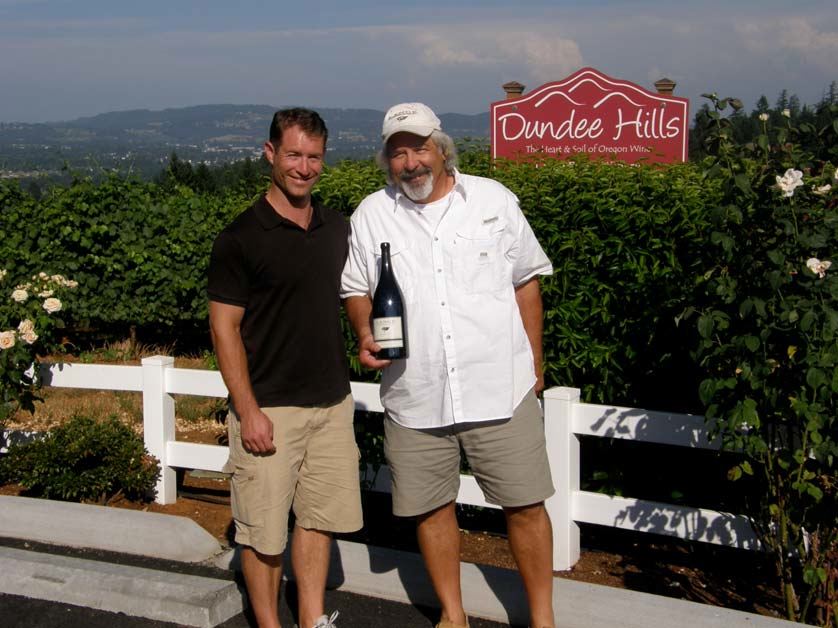 The third, and youngest member of the Lange family winery business is Jesse, a handsome, gregarious youth who is built like a major college football defensive back. Jesse joined the winemaking team in 2004 after his education. At the age of 20, he traveled to Central Otago, attending Lincoln University in Canterbury on an exchange program from Oregon State University. Enrolled in the enology and viticultural program there, Jesse was dirt poor and had to sell eight fishing rods that he had brought with him from Oregon to help pay the bills. This was not an easy decision as Jesse is an avid fisher and the flies that are prominently displayed on the Lange Estate labels reflect this passion. Jesse is very active in the Oregon wine industry, serving on several industry boards including the Dundee Hills Winegrowers Association, Oregon Pinot Camp, Willamette Valley Wineries Association and ¡Salud! Oregon Wine Auction. Today Lange Estate is known for its exceptional wines from grapes grown on the 40-acre winery Estate Vineyard (35 acres of Pinot Noir, 3 acres of Chardonnay and 2 acres of Pinot Gris) that has plantings dating back to 1988. To supplement their 17,000 case production, the Langes buy additional fruit from top notch vineyards in the surrounding appellations. Their long-standing relationship with these sites have allowed the winery to establish a well-deserved reputation for consistency in their wines. Currently, the father and son duo bottle six different Pinot Noirs. I visited Lange Estate after this year’s IPNC, toured the facility, tasted some precocious 2009 Pinot Noirs out of barrel, and sat down with Don and Jesse to sample wines from the 2008 and 2009 vintage. Three of the Pinot Noirs (Three Hills Cuvee, Estate Vineyard and Freedom Hill Vineyard) were tasted before IPNC at home, the striking quality of the wines prompting my visit. All the wines provide amazing fruit intensity at moderate alcohol levels framed with beautiful balance. Jesse notes that all the 2008 Lange Pinot Noirs are slowly showing better since bottling, but he advises patience for full enjoyment. The Lange Pinot Noirs in 2008 from Dundee Hills show more blue and black fruit than usual.
2009 Lange Three Hills Cuvee Willamette Valley Chardonnay 13.2% alc.. Debut release from three vineyards in the Northern Willamette Valley - Lange Estate Vineyard, Freedom Hill Vineyard, and Durant Vineyards. Partially fermented for 6 months in stainless steel and neutral French oak. All Dijon clones. · Similar in style to the winery’s Pinot Gris with bright, effusive fruitiness. Tropical fruit notes are prominent on the nose with hints of honeysuckle and Juicy Fruit. Bright and crisp on the palate with intense tutti fruiti, apple and citrus flavors rounding out a very refreshing wine. Good.
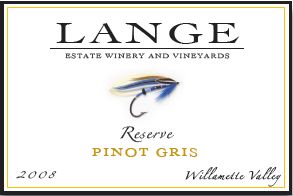 2009 Lange Reserve Willamette Valley Pinot Gris 12.9% alc., 900 cases, $22. Aged 5 months in neutral oak puncheons which lend weight and texture to the wine. Primarily sourced from Yamhill Vineyards with some Eyrie Vineyard fruit planted in 1984. The flagship white wine from Lange. · The aromatics are enticing, featuring scents of cut flowers, topical fruits and melons. Moderately rich on the palate with flavors of peaches and citrus zest with a mildly creamy mouth feel and a clean finish. A benchmark for Oregon Pinot Gris and a wine to cozy up to with roasted chicken or grilled salmon. Very good (+).
2008 Lange Reserve Willamette Valley Pinot Noir 13.7% alc., 1,500 cases, $32. Released November 1, 2009. Aged 11 months in 40% new French oak. Comprised of the most complex wines in the cellar, this is a multi-vineyard wine. All twelve vineyard sites are contributors which includes every soil type in the Willamette Valley and several appellations. · Lovely aromas of dark red berries, cherries and a hint of nuts and alcohol. Rich and full-bodied on the attack with flavors of red plums, dark berries, cola and coffee. Caressing tannins and a silky texture with some fruity persistence on the finish. Good.
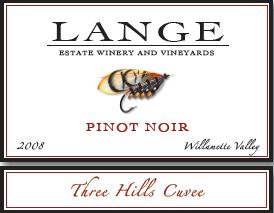 2008 Lange Three Hills Cuvee Willamette Valley Pinot Noir 13.5% alc., 720 cases, $40. Released May 1, 2010. A blend of grapes from Lange Estate Vineyard, Freedom Hill Vineyard and Yamhill Vineyards (1/3 each). This bottling debuted in 1997. Aged 12 months in 50% new French oak barrels. · Moderately deep reddishpurple color in the glass. Very pretty aromatics featuring black cherries, black raspberries, savory spices and a hint of seasoned oak. Very tasty, even decadent flavors of darker red fruits with hi-toned spiced cherry and red licorice notes. Moderately rich with fine, sandy tannins and bright acidity. Can easily be drunk now, but will be even better with more bottle age. Very good.
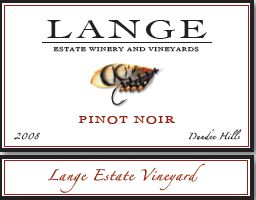 2008 Lange Estate Vineyard Dundee Hills Pinot Noir 13.5% alc., 295 cases, $60. Released May 1, 2010. Aged 12 months in 50% new French oak barrels. · Dark reddish-purple color in the glass. Very complex aromatics that constantly change in the glass revealing a diverse perfume of dark fruits, baking spices, underbrush, toast and smoke. Charming dark red and black fruit profile with well integrated oak toast and spice. Impressive persistence on the aromatic finish that sails along. Big, yet more demure than the Freedom Hill bottling with more emphasis on redder fruits. Beautifully composed with welcoming harmony. Definitely needs more time but can be a dinner table centerpiece with decanting. It is wines like this that make Pinot my paramour.
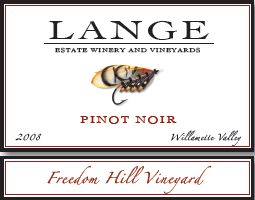 2008 Lange Freedom Hill Vineyard Willamette Valley Pinot Noir 13.5% alc., 250 cases, $60. Released May 1, 2010. Lange has been sourcing fruit from Freedom Hill Vineyard since 1990 and began making its namesake single-vineyard Pinot Noir in 1996. Typically, the wines from this vineyard have more structure and tannins, making it a very age worthy wine. · Moderately dark reddish-purple color in the glass. Restrained aromas of black cherries and blackberries on the nose with smoky oak taking charge. Big and juicy, thick and viscous, with serious fruit intensity. Dark fruits dominate the profile with an underlying earthiness. Mildly firm tannins reel in the massive fruit, and should soften with aging. This is a huge wine that will make many California Pinots seem wimpy by comparison. Needs time to shed its oak, integrate the tannins, and tame the explosion of fruit. An amazing gulp of old vines fruit. Ride this wine to heaven in a few years.
The Lange Estate Winery & Vineyards website at www.langewinery.com is very informative and well-designed. Wines are available for purchase on the website with discounts for wine club (Cru Club) members. The tasting room is open daily from 11:00 to 5:00. A private tour and tasting can be scheduled by appointment which includes a sit down tasting of reserve level wines including the single vineyard Pinot Noirs. A delightful book about Lange Estate, titled The Grail, and written by Brian Doyle, details a year “ambling and shambling through an Oregon vineyard in the pursuit of the best Pinot Noir wine in the whole wide world” (2006, Oregon University Press). A very entertaining read that is peppered with little known facts about Pinot Noir and the history of Pinot Noir winegrowing in Oregon, as well as personal insights into the Lange family.
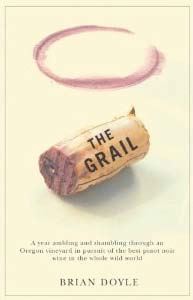
 The 2010 Dundee Hills Wine Experience will be held Thursday, August 26, 2010 in Portland. Three generations of winemakers are featured including the Founders from the 70s and 80s, the Legends who built the reputation of the Dundee Hills in the 90s and the Rising Stars who have made their mark over the last decade. Taste through older and current vintages from participating Dundee Hills wineries and feast on dishes from the best of the Dundee Hills restaurants. Visit www.dundeehils.org for information and tickets.
Update on The Four Graces Doe Ridge VineyardSteve and Paula Black bought a 110-acre property in the Red Hills of Dundee, and with the guidance of renowned winemaker Laurent Montalieu, created The Four Graces, named in honor of the Black’s four daughters, Alexis, Vanessa, Christiana, and Julian. Brother Nicholas is The Keeper of The Four Graces. The goal was to start a family business that could be left as a legacy to the Black’s children. Last year I visited the owner’s Doe Ridge Estate Vineyard, a 90-acre site in the Yamhill-Carlton District acquired and planted in 2005 (see report in the PinotFile, www.princeofpinot.com/article/577/). The vineyard at this exceptional site, which had been neglected and devastated by phylloxera, was completely replanted to launch a unique project. Two 20-acre parcels divided by a natural habitat ravine were planted to the same clones (Pommard, Dijon 115, 667, 777) and rootstocks (101-14 and Riparia Gloire) at 2555 vines per acre (1.9m x 1.0 m spacing). One parcel is farmed according to the Rudolph Steiner practice of Biodynamie under the guidance of French consultant, Philippe Armenier, and the other is farmed according to LIVE sustainability guidelines. Noted viticulturist, Matt Novak of Results Partners LLC Vineyard Development & Management directed the planting and oversees management of the vineyard. Laurent Montalieu has crafted the wines from this property, duplicating the winemaking from the two parcels, and the first wines now allow for early comparisons of the two parcels. This is the largest experiment of its kind in the world.
Pictured below is the Doe Ridge Vineyard in the distance photographed from a more northerly hill at Lenné
Estate. The riparian divide with stream is evident in the center of the two parcels. Also, the location of the
vineyard and its layout are depicted in the schematics below.
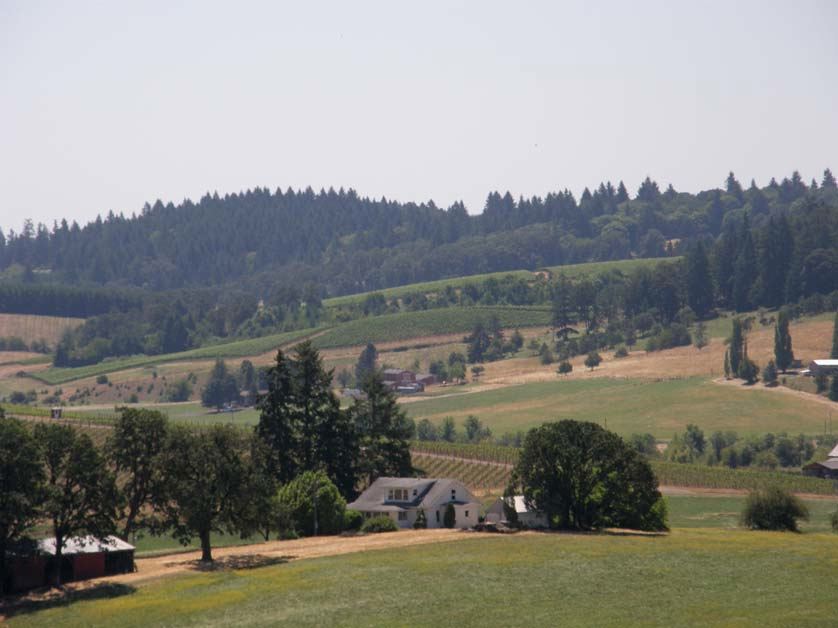
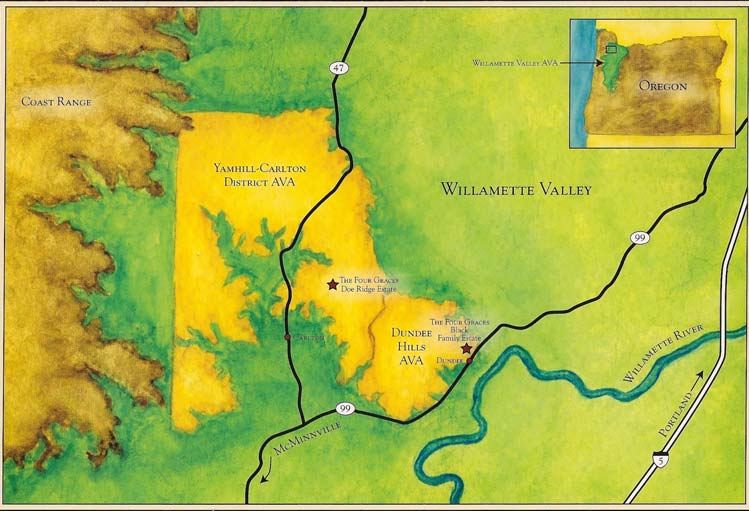
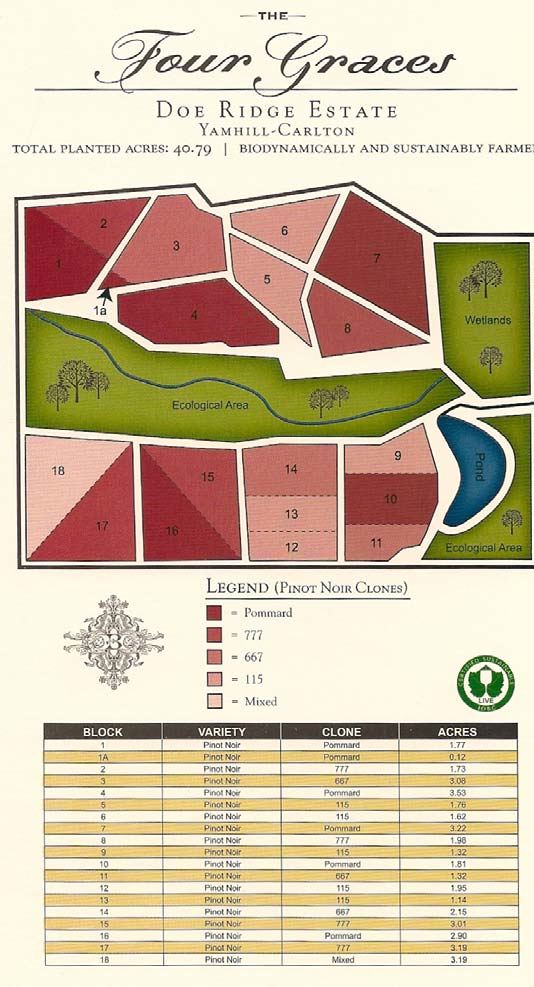 I visited The Four Graces recently after IPNC and sat down with Matt Novak and General Manager Anthony Van Nice to blind taste wines from the two parcels of the Doe Ridge Vineyard from the 2008 vintage (bottled samples) and 2009 vintage (barrel samples). The grapes for both wines were picked within 48 hours of each other, the clones are the same, and the wines received the same new oak treatment for 14 to 16 months. The wines from the two parcels were difficult to distinguish, especially from the 2009 unfinished wines, but there were subtle differences evident. Anthony and myself preferred the biodynamically-farmed wines in both vintages, while Matt preferred the biodynamically-farmed Pinot Noir in the 2008 vintage and the sustainablyfarmed Pinot Noir in the 2009 vintage. Obviously, many more tastings like this by experienced tasters will be necessary to discern any significant advantages of one form of farming versus the other. 2008 The Four Graces Doe Ridge Vineyard Biodynamie sample Very expressive nose with bright dark fruits, underbrush and an appealing savory note. Good mid-palate richness with vibrant fruit, ripe tannins and impressive persistence on the finish. I found the biggest difference between the two wines to be in the generous and lengthy finish of this wine. Preferred 2008 The Four Graces Doe Ridge Vineyard Sustainable sample Dark fruits are featured on the nose including blackberries and black raspberries and plums with a savory undertone. The flavors echo the aromas. Very tasty with an earthy underpinning and very fine ripe tannins. Pleasant but not lengthy finish. 2009 The Four Graces Doe Ridge Vineyard Biodynamie barrel sample Youthful and undeveloped but with demure fruity notes of dark raspberry and strawberry on the nose with hints of smoky oak and vanilla. Richer and riper than the 2008 with primal cherry cola flavor. Soft in the mouth with admirable mid palate force and fine grain tannins. Preferred. 2009 The Four Graces Doe Ridge Vineyard Sustainable barrel sample Aromas of raspberry and strawberry fruit with hints of smoky oak and mint. Leaner and redder than the biodynamie sample with more earthiness. Still linear with plenty of oak and tannin to shed. Since 2007, The Four Graces has bottled and sold a Doe Ridge Vineyard Pinot Noir composed of Pommard grapes from the entire vineyard. 2007 The Four Graces Doe Ridge Vineyard Willamette Valley Pinot Noir 13.5% alc.. (tasting room item, nearly sold out). Tasted briefly. Aromatically pure and uplifting with lovely cherry and red berry highlights and a hint of herbal oak. Tight-knit core of lovely red fruit flavors with fine, sandy tannins and perfect balance. Very good. 2008 The Four Graces Doe Ridge Vineyard Willamette Valley Pinot Noir Bottled 3 months, unreleased. Similar hi-tone aromatics of the 2007 vintage with enticing scents of cherries, berries, cola and oak. Beautifully composed essence of ripe fruit displaying discreet richness and staying power on the fruity finish. Should have tremendous potential over time. Very good.
The Four Graces tasting room is a charming small house beautifully landscaped in a peaceful setting just off Highway 99W in Dundee. The address is 9605 NE Fox Farm Road. The hours are 10:00 to 5:00 daily. You will be suitably entertained and warmly received by Aussie Jason Senior, the tasting room manager. The winery’s other offerings, including Pinot Gris and Pinot Blanc, are first class. Visit the website at www.thefourgraces.com.
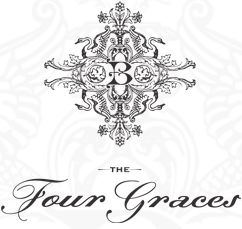
Longplay: Analog Wine for a Digital WorldYoung Todd Hansen is a new hound in the Pinot race and after spending some time speaking with him at Pinot Days San Francisco and IPNC, I believe he is a front runner. Foremost, he is a devoted winegrower assisted by noted viticulturist, Javier Marin, formerly of Shea Vineyard, who now operates his own vineyard management company.
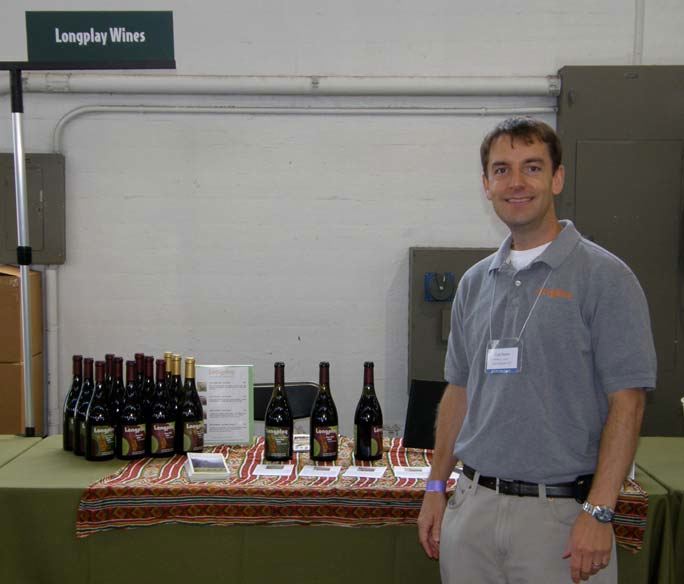 Todd’s Lia’s Vineyard (named after Todd’s baby daughter) is well situated in the Chahelam Mountains AVA at 380 to 560 feet with primarily a due south facing aspect. The vineyard was once part of the famed Rex Hill Jacob-Hart Vineyard. The soils are primarily Jory, with patches of sedimentary and loess type as well. 25 acres are planted to eight clones of Pinot Noir (Pommard, Wädenswil, Dijon 114, 115, 667, 777, 828, and Mariafeld) and 2 acres of Chardonnay (Wente Selection). The Pommard, Wädenswil and Wente Selection are all own-rooted with plantings dating back to 1990 to 1993. The newer plantings (1999-2002) are all on 101-14 rootstock, with 5’ x 9’ spacing and VSP trellising. The most recent plantings in 2009 are 3’ x 7’ and 4’ x 7’ spacing on RG, 101-14 and SO4 rootstocks. The vines are dry farmed. (More information on the Lia’s Vineyard is available on the vineyard’s website at www.liasvineyard.com). Todd produces a small amount of Pinot Noir and Chardonnay under the Longplay label. With my interest in old vinyl (I have an extensive collection of LPs and 45s from the 50s and 60s), the label really appeals to me. The winemaker is veteran Aron Hess, who crafts several labels at 12th and Maple Wine Co., including his own label, Daedalus Cellars. Todd asked me to review three of his wines and I was happy to do so. This is a project that holds considerable future potential. The wines are fine now, and worthy of your interest, but I believe the best is yet to come.
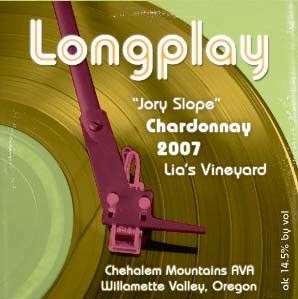 2008 Longplay “Jory Slope” Lia’s Vineyard Chehalem Mountains Willamette Valley Chardonnay 14.5% alc., pH 3.69, 63 cases, $24. 17-year-old vines. Aged 16 months on the lees in neutral oak. Low-yielding own-rooted Wente clone. · Lovely array of scents including apple pie, white peach, dried mango and marzipan. Very tasty green apple, white stone fruit and citrus core with an appealing hint of yeast. Pleasantly creamy and finishing with a spark of acidity. Proof positive that Wente clone can produce high quality Chardonnay in the Willamette Valley. Very good.
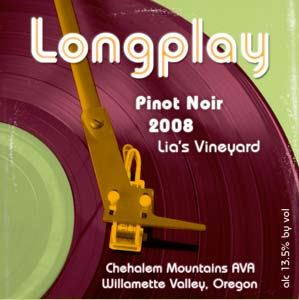 2008 Longplay Lia’s Vineyard Chehalem Mountains Willamette Valley Pinot Noir 13.5% alc., pH 3.95, 287 cases, $24. 55% Dijon 115, 20% Wädenswil, and 10% Mariafeld clones. Indigenous yeast fermentation. Aged in 10% new French oak barrels for 10 months. · Darker fruited scents with a floral note and an underlying roasted coffee aroma. Moderately rich essence of black cherries with a fine grain texture and a dry finish. Simple and easy to drink. Good.
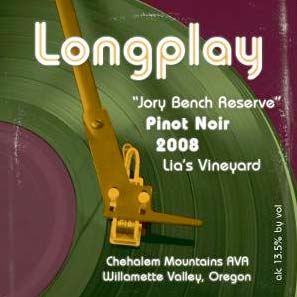 2008 Longplay “Jory Bench Reserve” Lia’s Vineyard Chehalem Mountains Willamette Valley Pinot Noir 13.5% alc., pH 3.95, 287 cases, $30. Four barrels in the cellar stood out composed of 25% Pommard, 25% Wädenswil, 40% Dijon 115, and 10% Mariafeld clones. Aged in 20% new and 80% seasoned French oak barrels for 10 months. · Demure fruit on the nose with a roasted coffee, toasty bent. Earth-kissed dark fruits with tar and coffee mocha notes. Still tight and significantly better the next day from a previously opened and re-corked bottle showing tasty black cherry essence with a subtle toasty oak tone. Definitely worth revisiting with another year or two in bottle. Good (+).
Longplay wines are available through the winery’s online shop at www.longplaywine.com
Small Sips of Oregon Pinot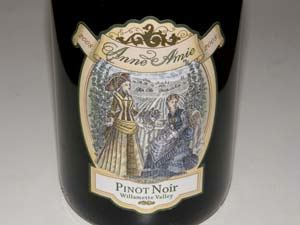 2008 Anne Amie Willamette Valley Pinot Noir 13.5% alc., December 2010 release, screw cap. Composed of grapes from 11 vineyards. Clones Pommard 4, 114, 115, 667, 777, 828. Aged 10 mos in 26% new, 20% 1-year-old, and 54% neutral French oak barrels. · Moderately dark reddish-purple color in the glass. Alluring aromas of crushed berries and dark red cherries with whiffs of Coca-Cola and rosehips. Flavors of black raspberries, strawberries, blackberries and cherry skins flood the mouth with pleasure, caressed by fine grain tannins and framed vividly by bright acidity. I couldn’t stop drinking this one. A terrific Willamette Valley blend that packs in plenty of pleasure. Kudos to winemaker Thomas Houseman who has brought Anne Amie into the upper echelon of Willamette Valley producers. A featured winery at the 2010 International Pinot Noir Celebration.
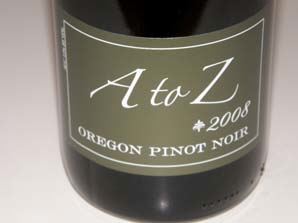 13.0% alc., $16, screw cap. A to Z Wineworks makes “Aristocratic wines at democratic prices.” · Moderately light reddish-purple color in the glass. Fragrant with berry and cherry fruits and some herbal oak and brioche notes. Light on the palate with a demure core of red stone fruits with hints of loamy earth, sage and a touch of citrus peel on the finish. Clean, direct, well-defined and well-priced. Good.
 2008 Klee Willamette Valley Pinot Noir 13.7% alc., $17. From Chris Berg’s Racine Wine Co. which also produces the Roots line of Willamette Valley wines. Paul Klee (1879-1940) was a famous teacher of the Bauhaus movement that emphasized functionality, affordability and consistence, all attributes of the Klee wines. The painting that inspired the label is at bauhaus.de. · The nuanced perfume is quite floral with added notes of wild berries, underbrush and spice. Soft and smooth and moderately rich in the mouth featuring dark red dried cherry and berry flavors, an underpinning of earthiness, and fine, ripe tannins. A dependable daily drinker. Good.
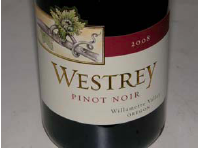 2008 Westrey Willamette Valley Pinot Noir 13.5% alc., $20. Winemakers are husband and wife Amy Wesselman and David Autrey. Unfiltered. · Moderate reddish-purple color in the glass. Lovely nose featuring dark red raspberries, ripe cherries and dried rose petals. Picks up fruit in the glass over time with notes of red hard cherry candy. Moderately light and soft on the palate with cherry notes persisting on the finish which features bright acidity. Can drink now, but like so many Oregon 08 Pinots, has the structure to age. Good (+).
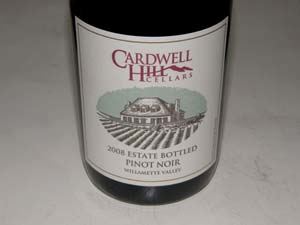 2008 Cardwell Hill Cellars Willamette Valley Pinot Noir 13.2% alc., $24. Wädenswil, Pommard, Dijon 115 and 777 clones from an estate vineyard in Philomath, Oregon. · The nose blossoms with time in the glass offering enticing aromas of deep, dark fruits, cut flowers, spice, oak and a hint of spearmint. Restrained but charming in the mouth with discreetly concentrated dark red cherries and berries and a slight note of grapefruit peel on the bright finish. This wine displays welcoming finesse in a well-crafted style offering great value. Very good.
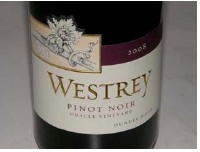 2008 Westrey Oracle Vineyard Dundee Hills Willamette Valley Pinot Noir 13.5% alc., $25. · Moderately dark reddish-purple color in the glass. Demure aromas of darker fruits with a hint of oak. Rich, silky and comforting on the palate with darker fruits grabbing the limelight. Not as expressive as would like with a little stem note. Impressive fruit core with the tannic structure and acidity to go the distance. Hold this wine in your cellar while you drink the Willamette Valley bottling. Very good.
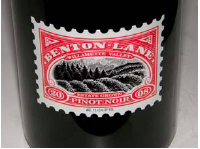 2008 Benton Lane Estate Grown Willamette Valley Pinot Noir 13.45%, pH 3.63, 16,670 cases, $26, screw cap. A featured winery at this year’s IPNC, Benton Lane was founded by Steve and Carol Girard in 1988. The stamp label is distinctive. 7 clones (Pommard, Wädenswil, Dijon 113, 114, 115, 667 and 777). Pneumatage employed (bubbles of air rise through fermenting wine breaking up the cap allowing excellent extraction of color and flavor. Aged 9 months in French oak barrels. Winemaker Chris Mazepink. · Lovely berry melange on the nose. An easy drinker that is light in the mouth with flavorful notes of spicy dark red berries with an earthy undertone. Ready to grace the dinner table now. Very good.
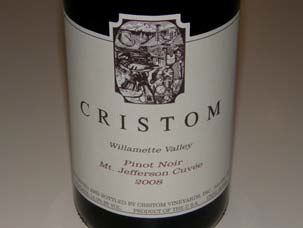 2008 Cristom Mt Jefferson Cuvée Willamette Valley Pinot Noir 14.0% alc., $26. Always the first of Cristom’s Pinot Noir releases each vintage. · Moderately deep reddish-purple robe. Intoxicating aromas of dark berry tart and exotic baking spices. Delicious, crisp and juicy berry fruit set off by an intense spiciness that is something I love in Pinot Noir. Harmoniously crafted offering brisk acidity that lifts the refreshing finish. A beautiful wine that is fairly forward for an 08 and can be enjoyed now. Very good (+).
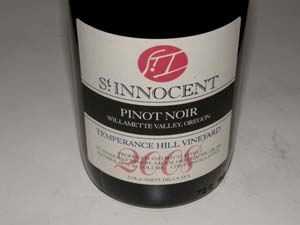 2008 St. Innocent Temperance Hill Eola-Amity Hills Willamette Valley Pinot Noir 13.5% alc., 656 cases, $30. The vineyard is ten miles northwest of Salem, OR. Sourced from blocks planted in 1984 and 1995 on thin basalt soil. Yields 1.6 tons/acre. · The nose draws you in with a perfume of dark berry fruits, rose petals and subtle oak char. Soft and sensual in the mouth with layers of flavor including tastes of red and purple fruits, cola, tar, brown spice, root beer and herbs. A thread of oak runs thru. Elegantly styled and alluring, but needs time to open in the glass. The label advises decanting now and I agree completely. An excellent cellar candidate that will reward patience. Very good.
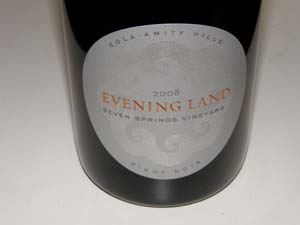 2008 Evening Land Seven Springs Vineyard Eola-Amity Hills Pinot Noir 13.5% alc., $35. From The Evening Land Vineyards, Salem, OR. · Aromas of dark cherries, wooded forest and oak. Charming cherry and raspberry fruit with a hint of oak-derived vanillin, smoke and grilled meats. The tannins are restrained and the fruit-packed finish lingers. Needs time to reach its full expression and allow the oak to integrate, but a solid wine that will shine. Very good.
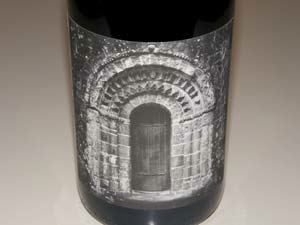 2008 Owen Roe The Kilmore Yamhill-Carlton District Willamette Valley Pinot Noir 14.1% alc., $35. Pommard, Wädenswil, and Dijon clones from selected unnamed vineyard sites. · Moderately deep color. Subdued aromas of berry compote, wet earth, mushroom and subtle spice. Hints at greatness but is closed. Tight in the mouth offering glimpses of black cherry fruit and some mocha magic. Nicely crafted, but like many 08 Pinots from Oregon, just not exciting now and needs cellaring. Very good.
 2008 Beaux Frères Willamette Valley Pinot Noir 14.0% alc., $40. Unfined and unfiltered. 49% Zena Crown Vineyard, 33% Shea Vineyard, 18% Amalie Robert Vineyard. · Nicely perfumed with darker red fruits, red roses and savory spices. A modest wine that aims to please with attractive flavors of dark red berries, cherries and red licorice. A comforting mouthfeel and soft tannins add to the appeal. Fine, but not exciting, and expensive for what it is. Good.
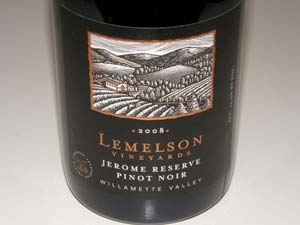 2008 Lemelson Vineyards Jerome Reserve Willamette Valley Pinot Noir 14.0% alc., $40. · Very dark reddish-purple color in the glass. Demure scents of blackberries and raspberries with a touch of smoky oak. Rich and full-bodied on the palate featuring purple fruits, an underpinning of smoky oak and an uplifting grip of acidity on the finish. A fruit-driven wine that speaks to hedonists, but retains an elegant and silky edge. Still linear at this stage in its evolution and needs more time. Good (+).
 2008 Elk Cove Mount Richmond Willamette Valley Pinot Noir 13.5% alc., pH 3.68, 894 cases, $48. From a vineyard planted in high density format in 1996 with old Pommard cuttings from Roosevelt Vineyard. Clones 115 and 777 add to the mix. · Dark reddish-purple color in the glass. Aromas of dark plums and tea with oak. Full-bodied hedonistic fruit buried in oak and tannin at present. Just doesn’t offer a load of pleasure now and needs time in the cellar to integrate the oak and tannin. Good.
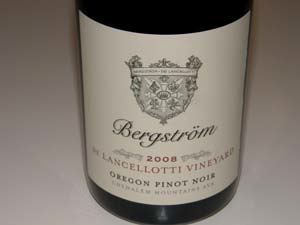 2008 Bergström De Lancellotti Vineyard Chehalem Mountains Oregon Pinot Noir 13.6% alc., $50. Demeter certified Biodynamic® vineyard. · Moderate reddishpurple hue in the glass. Very shy fruit on the nose with hints of brioche and cut flowers. Hi-tone red and black fruits with undertones of pomegranate, edible flowers and oak. Great purity of fruit, silky textured, with admirable elegance and harmony. Needs cellaring. Very good.
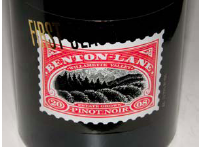 2008 Benton Lane Estate Grown First Class Willamette Valley Pinot Noir 13.75% alc., pH 3.77, 740 cases, $60. Classy label and screw cap. Only produced in special vintages. A selection of the best lots in the cellar aged 16 months in French oak barrels. The barrels were pre-blended to ensure consistency and then racked into barrels to complete the aging process. · Moderate reddish-purple color in the glass. Wonderful perfume of spiced dark cherry and berry fruits, anise, and red rose petals, picking up intensity over time. Delicious raspberry and cherry cola flavors cloaked in ripe, fine-grain tannins leading to a pleasingly aromatic and persistent finish. A sophisticated wine that is both sensual and beautifully crafted. This wine will find many fans.
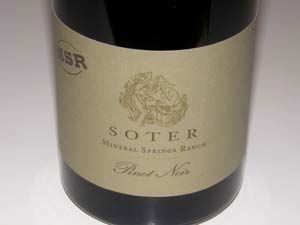 2007 Soter Mineral Springs Ranch Yamhill-Carlton District Willamette Valley Pinot Noir 13.8% alc., $40. · Deeply colored in the glass. Lovely core of purple fruits on the nose with whiffs of breakfast (bacon and mocha java coffee). Tasty, rich and ripe on the palate featuring flavors of blackberry jam, cassis and black cherries with a sidecar of earth and toast. Full-bodied, but retains an appealing elegance. Still a Lolita. A perfect example of why the 2007 vintage in Oregon should not be overlooked, especially from proven winegrowers such as Tony Soter. Even better the next day from a previously opened and re-corked bottle. Very good.
Books Worth a Read
The Wild Vine: A Forgotten Grape and the Untold Story of American WineTodd Kliman, Random House, 2010
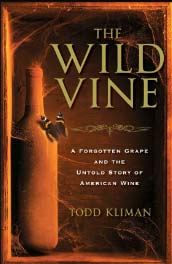 This is an impressively researched book about the Norton grape, a discovery in the 1820s by Dr. Daniel Norton who fortuitously uncovered a hybrid grape that could survive the harsh eastern New World climate, and produce good, even very good wine, something that the early colonists and Thomas Jefferson were never unable to achieve. The tale continues in Missouri where German immigrants cultivated the Norton grape ( it is known there as Norton-Cynthiana) and produced a landmark bottling in 1873. Several generations later, Dennis Horton brought cuttings back to Virginia, which were the first plantings of the grape in Virginia since repeal. The first Horton Norton was released in 1992. Jenni McCloud, a transgendered dot-com-millionaire-turned- vintner developed a strong affinity with the Norton grape and became its champion, committed to developing the largest planting of it anywhere in the world. She released her first Norton wine, the Chrysalis Norton Locksley Reserve, in 2000. The Norton grape makes a divisive wine with some liking it, a few loving it, and most disdaining it. It is an intense, inky red wine that likely will never find wide appeal. Despite that, the story of its history is captivating as portrayed by Todd Kliman, a highly respected James Beard Foundation Award winning food and wine writer. After reading this book I had to find a bottle of Norton just to complete the story. I searched my neighborhood in Southern California including several large retail wine stores, but was unable to locate a single bottling of Norton. Virginia wines, let alone Norton, are obscure in Virginia and even rarer in California. Norton just can’t seem to find a market. As for Virginians, Kliman notes, “At the mere mention of the name, most would allow their mouths to curl in a little smirk of a smile.” I will withhold any similar disparaging behavior since this story has left me with a thirsty curiosity which will not be satiated until I find a bottle of Norton. Listen to the Grape Radio program on the Norton grape and Chrysalis Vineyards: www.graperadio.com/archives/2009/09/14/norton-grape-chrysalis-vineyards
From Demon to Darling: A Legal History of Wine in AmericaRichard Mendelson, University of California Press, 2009
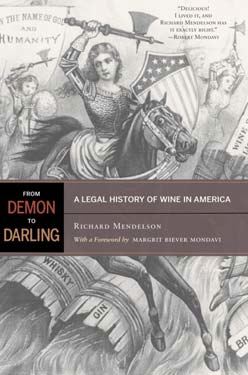 Richard Mendelson is certainly qualified to tell this history as he is both a practicing lawyer in Napa Valley and a winemaker. He is the director of the Program on Wine Law and Policy at the University of California at Berkeley School of Law. If you live in the United States, you have been affected in one way or another by our archaic and complex state wine shipping laws. Certainly HR5034 is on most wine enthusiasts’ mind currently as it represents a threat to legal, regulated winery-to-consumer shipping that is now successfully operative in 37 states. In a concise (less than 200 pages), to the point and organized chronological history, Mendelson details how we have arrived at the complex issue of who can distribute and freely buy wine in this country under the complex array of both federal and state requirements. Your first reaction might be that this book is a boring legal treatise filled with legalese and complex dissertation on fine point wine laws. Nothing could be further from the truth. This is a very easy reading, insightful story about the rise and fall of social movements, Prohibition, the origins of the appellation model, and current wine laws, told in an easily understandable fashion. If you are so inclined, there are numerous legal citations in the back note references, but most readers will not be interested in or distracted by these. I have marked several pages in the book, intending to use it as a valuable historical reference.
Daring Pairings: A Master Sommelier Matches Distinctive Wines with Recipes from His Favorite ChefsEvan Goldstein, University of California Press, 2010
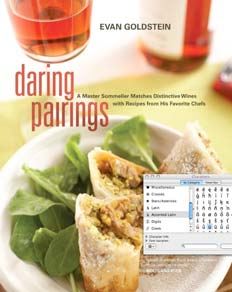 I had the distinct honor of meeting Evan at this year’s IPNC and interviewing him for a video documentary on the event. After the interview, we sat and talked for quite a while, and I became mesmerized by this dynamo who is bursting with knowledge and enthusiasm for wine and food. Evan is a Master Sommelier and a prolific food and wine industry veteran whose career began in the kitchens of Paris and California including Berkeley’s Chez Panisse. In 1984, he joined his mother, chef and author Joyce Goldstein, in opening the celebrated San Francisco restaurant Square One. Three years later, he became the eight American and youngest ever at the time to pass the Master Sommelier examination. Since 1990 Evan has created wine education programs and service hospitality schools, as well as trained and examined candidates for the Court of Master Sommeliers as a Founding Board Member. He has authored several critically acclaimed books including Perfect Pairings: A Master Sommelier’s Practical Advice for Partnering Wine with Food and this sequel. He is currently President and Chief Education Officer of Full Circle Wine Solutions, Inc., and may soon have his own television show on food and wine. This book takes off after Evan’s first book, Perfect Pairings, exploring food pairings for thirty-six less conventional grape varieties like Albarino, Grenache, Grüner Veltliner, Nebbiolo, Tempranillo and even Xinomavro. Each grape variety is discussed in detail including sources throughout the world, recommended importers and different styles available. This is followed by pairing pointers that tell the reader what goes well with each wine and what isn’t a good match. Thirty-six star chefs, including Suzanne Goin, Cindy Pawlcyn, and Charles Trotter offer recipes to match Evan’s wine selections. Both Evan and the chef comment about the chosen recipe. Full color photographs of the dishes are mouth watering. This combination wine book and cook book successfully demystifies food and wine pairings in a down-to-earth fashion. Once you have digested the “Keys to Understanding Food,” and drank in the “The Keys to Understanding Wine,” you can fully grasp and enjoy the art and science of wine and food pairing. Like a sommelier friend told me, “Once you find the perfect wine and food match, it will bring you to your knees.”
Essential Wines and Wineries of the Pacific NorthwestCole Danehower, Photography by Andrea JohnsonTimber Press, 2010
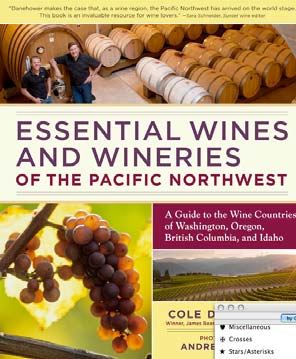 Finally someone has written a definitive book on the wine regions of Washington, Oregon, British Columbia and Idaho. Certainly author Cole Danehower is the one most qualified to do it. A noted wine journalist and winner of the prestigious James Beard Foundation Journalism Award, Cole is also co-publisher of Northwest Palate and author of that magazine’s popular “Inside Northwest Wine” column. Its nearly 300 pages, contain a short, but informative general overview of the Pacific Northwest wine region with a useful glossary, followed by a more detailed discussion of the topography, geology, climate, and history of each major region. The wineries that are then described are purely the author’s choice based on his experienced palate and the importance and reputation of the winery. Cole has personally visited the recommended wineries, met the winemakers, and/or tasted extensively the wines of each listed winery. The wineries chosen represent less than 10% of the Northwest’s wineries, but those that are detailed stand out for their excellence. This is a very handy book, that although not pocketbook size, is small enough to easily throw into a backpack or large purse. The wineries featured provide an opportunity to launch an exploration of each wine region and the detailed information on each winery will greatly assist in touring. The striking photographs of talented Andrea Johnson bring Northwest wine country to life. Andrea is an award-winning freelance photographer whose work has appearing in many wine magazines as well as National Geographic and Sunset. She has a love for wine that shows in the dreamy photos included in this definitive work.
Note: Although I have not reviewed the book yet, I want to alert you to the publication of The Pearl of the Côte: The Great Wines of Vosne-Romanée, written by renowned Burgundy expert, Allen Meadows. The book is currently available through www.burghoundbooks.com.
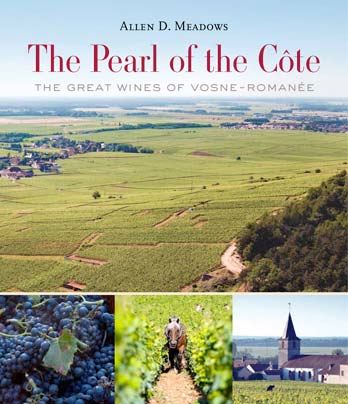
Ten Commandments of Pinot Noir
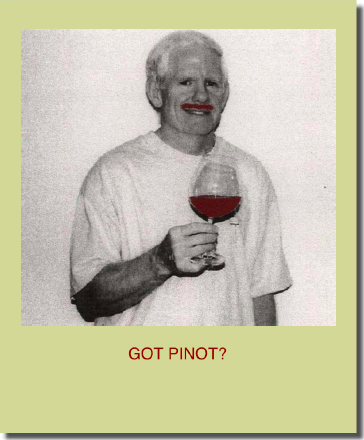 1. Let Pinot Noir breath. No other grape changes so quickly and constantly in the glass. 2. Drink Pinot Noir at 60° to 65°, especially if the alcohol is above 14.5%. 3. Give Pinot Noir some bottle age. If you must drink it soon after release, decant it. 4. Develop your own palate preferences for Pinot Noir and stick with producers who craft wines that suit your style. Don’t chase hi-scoring wines or cult labels. 5. Look to Oregon Pinot Noir if you want lower alcohol and generous acidity in your Pinot Noir. 6. Visit wineries and get to know the people that make the wine. Volunteer to work crush. 7. Attend at least one major Pinot Noir celebration in California or Oregon every year. 8. Embrace Pinot Noir in all of its styles, variations and origins. Try to drink Pinot Noir at its source with local foods. 9. Remember, Pinot Noirs that are balanced when young are balanced forever. Pinot Noirs that are not balanced when young, will never be, and will age poorly. 10. Read the PinotFile religiously.
Kathy Joseph, Winemaker, Fiddlehead Cellars |